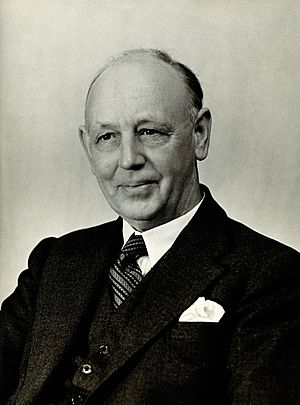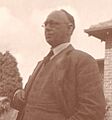Charles Kellaway facts for kids
Quick facts for kids
Charles Halliley Kellaway
|
|
|---|---|
 |
|
| Born | 16 January 1889 Melbourne, Australia
|
| Died | 13 December 1952 (aged 63) London, England
|
| Alma mater | Melbourne Grammar University of Melbourne |
| Awards | Burfitt Prize and Medal of the Royal Society of New South Wales (1932) Fellow of the Royal Society of London (1940) Vice President, Royal Australasian College of Physicians (1942–44) |
| Scientific career | |
| Fields | Physiology, pharmacology, snake venoms |
| Institutions |
|
| Influences | Henry Hallett Dale Charles James Martin |
| Influenced | Frank Macfarlane Burnet Wilhelm Feldberg Everton Trethewie George Reid Ian Wood |
Charles Halliley Kellaway (born January 16, 1889 – died December 13, 1952) was an important Australian medical scientist. He was known for his amazing research and for helping to organize science in Australia. He made big discoveries about how snake venoms affect the body. He also helped create a strong system for medical research in his home country.
Contents
- Who Was Charles Kellaway?
- His Early Life and School Days
- Serving in World War I and Training in Britain
- Leading the Walter and Eliza Hall Institute
- Amazing Research on Australian Snake Venoms
- Helping Australian Medical Research Grow
- His Role in World War II and International Science
- Final Years in Britain
- His Personal Qualities
- See also
- Images for kids
Who Was Charles Kellaway?
His Early Life and School Days
Charles Kellaway was born in Melbourne, Australia. His father was a church minister. Charles first wanted to be a medical missionary in Egypt. But his ideas changed after the sad events of World War I.
He went to school at home until he was 11. Then he attended Caulfield Grammar School and later Melbourne Church of England Grammar School. In 1907, he started studying medicine at the University of Melbourne. He worked very hard and finished his medical degrees by 1915. People said he was the smartest medical student the university had ever seen!
Serving in World War I and Training in Britain
In 1914, Charles Kellaway became a professor of anatomy at the University of Adelaide. In 1915, he joined the army as a captain. He served in Egypt and Flanders during World War I. He was very brave and received a special award called the Military Cross.
During the war, he met important scientists like Charles Martin and Henry Dale. They encouraged his love for science. He started researching how a lack of oxygen affects the body. After the war, he won a special scholarship. This allowed him to return to Britain from 1920 to 1923. He worked with famous scientists at places like the National Institute for Medical Research. These years helped him decide what kind of science he wanted to do. They also shaped his ideas about how medical research should be done in Australia.
Leading the Walter and Eliza Hall Institute
In 1923, Charles Kellaway moved back to Melbourne. He became the director of the Walter and Eliza Hall Institute of Research. This institute is now known as the Walter and Eliza Hall Institute of Medical Research.
As director, he worked hard to get more money for the institute. He talked to doctors and business people. This helped him get important donations. These gifts allowed the institute to build a library and a new biochemistry department. He also changed how the institute did its science. He organized it into three main research areas:
- Biochemistry: The study of life's chemical processes.
- Bacteriology: The study of tiny living things like bacteria.
- Physiology: The study of how living things work.
His own research covered different topics, including kidney disease.
In 1928, he led an important investigation. Twelve children had died after getting a diphtheria shot in Bundaberg. Charles Kellaway's careful investigation helped show that the immunization program was safe. This also brought him international attention.
Amazing Research on Australian Snake Venoms
In 1927, Charles Kellaway found his true passion: studying Australian snake venoms. He worked with other scientists and even a snake catcher from the Melbourne Zoo. They studied venoms from many Australian snakes, like the tiger snake and death adder.
Their work focused on:
- How snakes bite.
- How much venom they produce.
- How venom affects the body.
- How deadly the venom is.
- How the body reacts to venom (immunology).
They also looked into the best first-aid for snakebites. They worked on creating antivenoms, which are medicines that fight venom. They made antivenom for the tiger snake, which is still used today.
His research also expanded to include venoms from the platypus, mussels, and even spiders like the Sydney funnel-web spider. He published over 70 scientific papers on this topic. In 1936, he was invited to give special lectures in the United States. This showed how important his work was around the world.
His studies also looked at how venoms hurt body tissues. He researched how venoms affect blood flow and cause allergic reactions. This led to new discoveries about chemicals the body releases when it's injured. This work helped start a whole new field of study in medicine.
Helping Australian Medical Research Grow
Charles Kellaway did more than just research. He also helped build a strong system for medical research in Australia. In the 1920s and 1930s, there were not many medical research centers in Australia. The Hall Institute, under Kellaway, became a great example for young scientists.
He worked hard to show how valuable medical research was. He talked to doctors, the public, and politicians. In 1934, he helped get money from the Australian government and the Rockefeller Foundation. This money helped create a new virus research department at the Hall Institute. This was an important step that led to the creation of the National Health and Medical Research Council (NH&MRC) in 1937. Charles Kellaway strongly supported forming this group.
He was also known for encouraging his staff and young researchers. Other new research centers asked for his advice. He became a Vice-President of the Royal Australasian College of Physicians. This was a great honor for someone who was not a practicing doctor.
His Role in World War II and International Science
By the start of World War II, Charles Kellaway was one of Australia's most important medical scientists. He moved from working in the lab to helping with organization. He supported the early work on blood banks at the Hall Institute. When the war began, he let the Red Cross use the institute's facilities. They collected and stored blood for soldiers.
He rejoined the army and helped with hygiene and pathology. He also joined a committee that studied how flying affected pilots. In 1941–42, he traveled to the US, Canada, and the UK. His job was to help different countries work together on wartime medical research. He helped coordinate many important projects. He stopped his own lab work in 1943. He knew that the war had made the government realize how important it was to support medical research in Australia.
Final Years in Britain
In 1943, Charles Kellaway was offered a job in London. He became the Director of Scientific Policy at the Wellcome Research Laboratories. This company is now part of GlaxoSmithKline. He was sad to leave Australia, but he accepted the job. He stayed in Australia until March 1944 and became an honorary Brigadier in the Army.
At Wellcome, he did not return to lab work. But his great organizational skills and inspiring personality helped the company rebuild its research. They found new treatments for things like motion sickness and malaria. These discoveries started to make money for Wellcome just as Charles Kellaway was diagnosed with lung cancer in 1951. He also stayed active in the Royal Society. He continued to help Australian researchers whenever he could. Sadly, he died on December 13, 1952, without returning to Australia.
His Personal Qualities
Beyond his scientific work, Charles Kellaway had many hobbies. He was a talented bird photographer and a good fly fisherman. He loved the Australian bush and spent holidays in remote areas. He married Eileen Ethel Scantlebury in 1919. They had three sons.
When he died, many people praised him. They remembered his kindness, charm, and good humor. They also honored his huge contribution to making the Hall Institute a world-class center. He helped create a strong and supportive environment for medical research in Australia.
See also
- List of Caulfield Grammar School people
Images for kids




